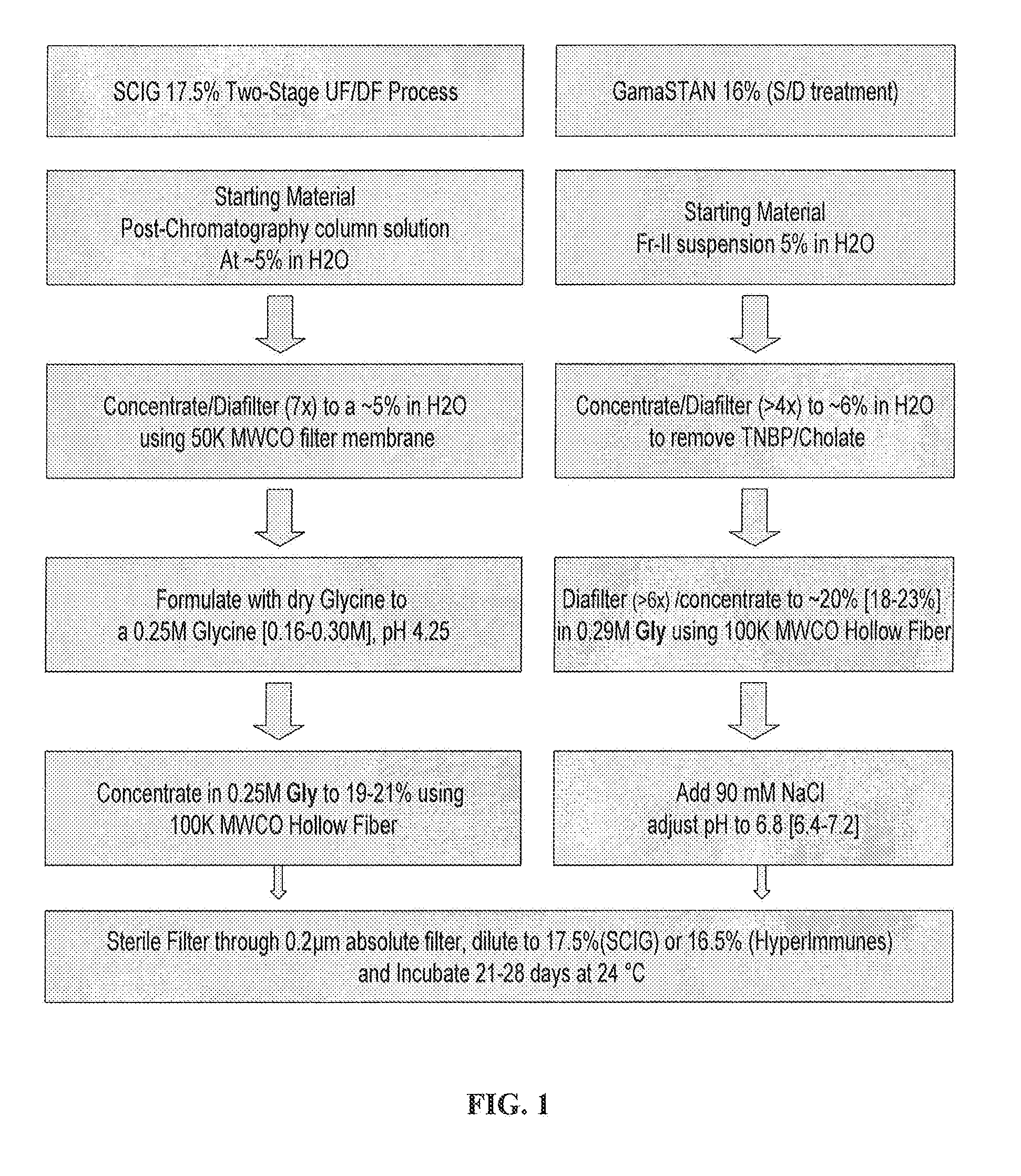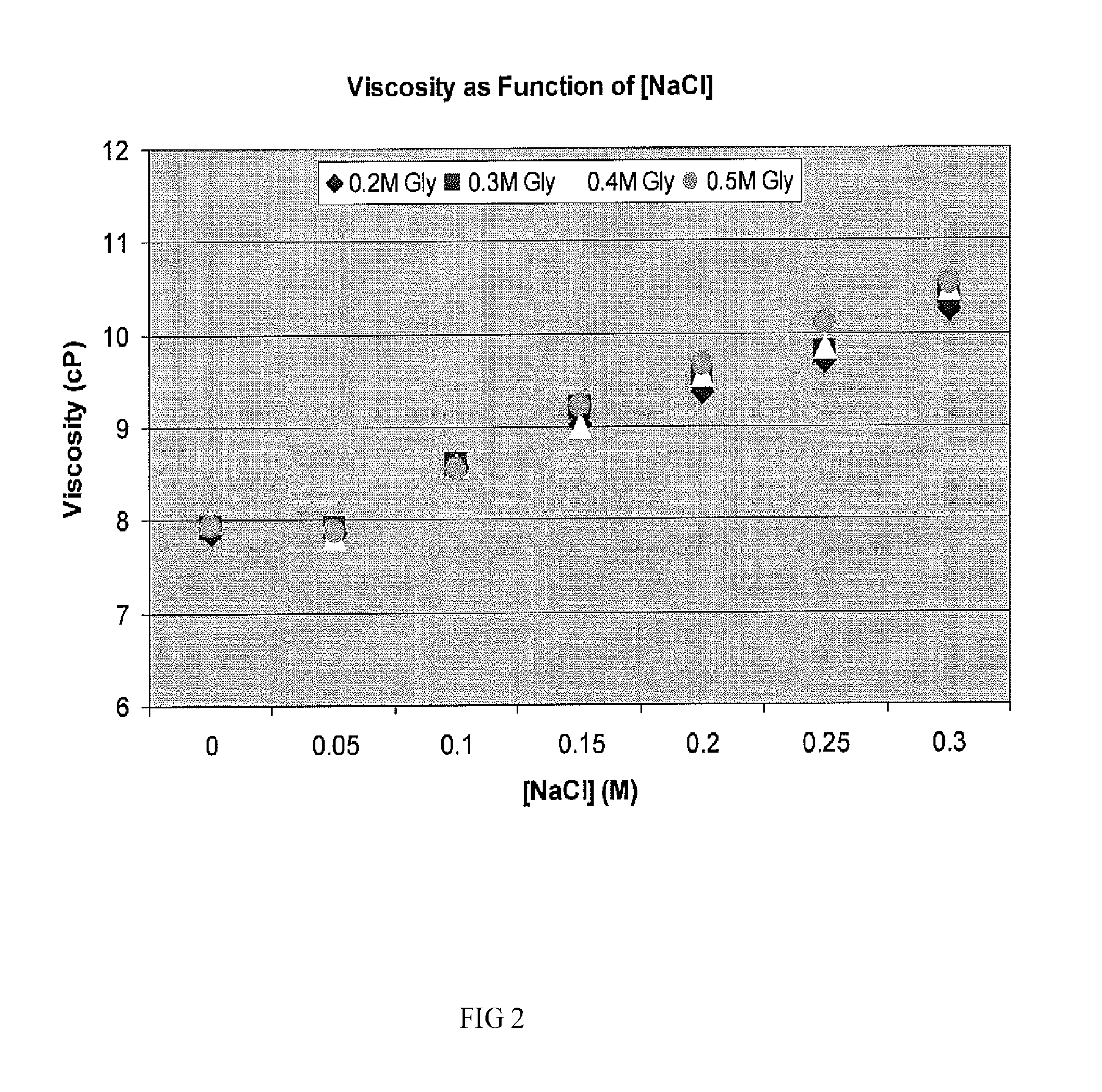Two-stage ultrafiltration/diafiltration
a technology of ultrafiltration and diafiltration, applied in the field of concentrated protein preparation, can solve the problem of greatly reduced product recovery
- Summary
- Abstract
- Description
- Claims
- Application Information
AI Technical Summary
Benefits of technology
Problems solved by technology
Method used
Image
Examples
example 1
Purification of IgG from Cohn Fraction II+III Paste
[0079]Fraction II+III paste is solubilized in 12 volumes of 5° C. purified water. The mixture pH is adjusted to pH 4.2 with acetic acid, and mixed for 1 hour. This step places the IgG into solution.
[0080]The mixture pH is then adjusted up to pH 5.2 with NaOH and sodium caprylate (the “pH swing”). Proteins and lipids are precipitated. The mixture is clarified by filtration to remove precipitate which would interfere with virus inactivation. The caprylate concentration is adjusted to 20 mM at pH 5.1, and the mixture is incubated for 1 hour at 25° C. to effect enveloped virus inactivation.
[0081]The mixture is filtered to produce a clear solution for chromatography. The clear solution conductivity is adjusted to between 2.0 and 3.0 mS / cm using purified water. The pH of the clear solution is adjusted to 5.0 to 5.2 following the conductivity adjustment.
example 2
[0082]The clear solution above is applied directly to two anion exchange columns (a strong anion exchanger followed by a weak anion exchanger) linked in series. The IgG flows through the column while impurities (including the caprylate) are bound to the two anion columns. Satisfactory purifications are obtained with combinations of Pharmacia Biotech Q & ANX resins and E. Merck TMAE Fractogel.
[0083]The clear solution comprising the IgG to be purified is applied directly to the first anion exchanger which is equilibrated with 20 mM sodium acetate at pH 5.1. This is followed by applying the non-binding fraction (the flow through) from the first anion exchange column directly onto a second anion exchange column. This column is also equilibrated with 20 mM acetate buffer at pH 5.1. The protein solution is typically loaded onto the first column at a ratio of 50-110 mg IgG / ml packed resin. The protein solution is typically loaded onto the second column at a ratio of 75-95 mg ...
example 3
Two-Stage Ultrafiltration / Diafiltration (UF / DF)
[0084]The solution comprising the IgG (i.e., the post-chromatography column solution) is concentrated to about 5% IgG (w / v) bulk material using a polyethersulfone C-screen membrane having a molecular weight cutoff of 50 kDa. The concentrated solution temperature is maintained between 2° C. and 12° C. Following diafiltering of the 5% solution with CWFI, the system is rinsed and the recovered material is added to the bulk material. The concentrated solution is then formulated to 0.25M Glycine by adding dry glycine in powder, and the pH is adjusted as needed. The filter membrane performance is not affected (by soiling or clogging) since the protein is only concentrated to 5% (w / v).
[0085]Following the formulation step, the 5% solution in 0.25M Glycine is then transferred to a second ultrafiltration unit for further concentration using a hollow fiber membrane having a molecular weight cutoff of 100 kDa. The material is concentrated to at lea...
PUM
| Property | Measurement | Unit |
|---|---|---|
| molecular weight | aaaaa | aaaaa |
| molecular weight | aaaaa | aaaaa |
| molecular weight | aaaaa | aaaaa |
Abstract
Description
Claims
Application Information
 Login to View More
Login to View More - R&D
- Intellectual Property
- Life Sciences
- Materials
- Tech Scout
- Unparalleled Data Quality
- Higher Quality Content
- 60% Fewer Hallucinations
Browse by: Latest US Patents, China's latest patents, Technical Efficacy Thesaurus, Application Domain, Technology Topic, Popular Technical Reports.
© 2025 PatSnap. All rights reserved.Legal|Privacy policy|Modern Slavery Act Transparency Statement|Sitemap|About US| Contact US: help@patsnap.com



